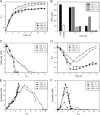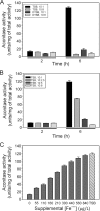Influence of iron and aeration on Staphylococcus aureus growth, metabolism, and transcription
- PMID: 24706736
- PMCID: PMC4054190
- DOI: 10.1128/JB.01475-14
Influence of iron and aeration on Staphylococcus aureus growth, metabolism, and transcription
Abstract
Staphylococcus aureus is a prominent nosocomial pathogen and a major cause of biomaterial-associated infections. The success of S. aureus as a pathogen is due in part to its ability to adapt to stressful environments. As an example, the transition from residing in the nares to residing in the blood or deeper tissues is accompanied by changes in the availability of nutrients and elements such as oxygen and iron. As such, nutrients, oxygen, and iron are important determinants of virulence factor synthesis in S. aureus. In addition to influencing virulence factor synthesis, oxygen and iron are critical cofactors in enzymatic and electron transfer reactions; thus, a change in iron or oxygen availability alters the bacterial metabolome. Changes in metabolism create intracellular signals that alter the activity of metabolite-responsive regulators such as CodY, RpiRc, and CcpA. To assess the extent of metabolomic changes associated with oxygen and iron limitation, S. aureus cells were cultivated in iron-limited medium and/or with decreasing aeration, and the metabolomes were examined by nuclear magnetic resonance (NMR) spectroscopy. As expected, oxygen and iron limitation dramatically decreased tricarboxylic acid (TCA) cycle activity, creating a metabolic block and significantly altering the metabolome. These changes were most prominent during post-exponential-phase growth, when TCA cycle activity was maximal. Importantly, many of the effects of iron limitation were obscured by aeration limitation. Aeration limitation not only obscured the metabolic effects of iron limitation but also overrode the transcription of iron-regulated genes. Finally, in contrast to previous speculation, we confirmed that acidification of the culture medium occurs independent of the availability of iron.
Copyright © 2014, American Society for Microbiology. All Rights Reserved.
Figures






Similar articles
-
Catabolite control protein E (CcpE) is a LysR-type transcriptional regulator of tricarboxylic acid cycle activity in Staphylococcus aureus.J Biol Chem. 2013 Dec 13;288(50):36116-28. doi: 10.1074/jbc.M113.516302. Epub 2013 Nov 5. J Biol Chem. 2013. PMID: 24194525 Free PMC article.
-
Guanine Limitation Results in CodY-Dependent and -Independent Alteration of Staphylococcus aureus Physiology and Gene Expression.J Bacteriol. 2018 Jun 25;200(14):e00136-18. doi: 10.1128/JB.00136-18. Print 2018 Jul 15. J Bacteriol. 2018. PMID: 29712876 Free PMC article.
-
Staphylococcus aureus Coordinates Leukocidin Expression and Pathogenesis by Sensing Metabolic Fluxes via RpiRc.mBio. 2016 Jun 21;7(3):e00818-16. doi: 10.1128/mBio.00818-16. mBio. 2016. PMID: 27329753 Free PMC article.
-
Metabolic control of virulence factor production in Staphylococcus aureus.Curr Opin Microbiol. 2020 Jun;55:81-87. doi: 10.1016/j.mib.2020.03.004. Epub 2020 May 7. Curr Opin Microbiol. 2020. PMID: 32388086 Free PMC article. Review.
-
At the crossroads of bacterial metabolism and virulence factor synthesis in Staphylococci.Microbiol Mol Biol Rev. 2009 Jun;73(2):233-48. doi: 10.1128/MMBR.00005-09. Microbiol Mol Biol Rev. 2009. PMID: 19487727 Free PMC article. Review.
Cited by
-
Human Serum Alters the Metabolism and Antibiotic Susceptibility of Staphylococcus aureus.J Proteome Res. 2022 Jun 3;21(6):1467-1474. doi: 10.1021/acs.jproteome.2c00073. Epub 2022 May 10. J Proteome Res. 2022. PMID: 35537087 Free PMC article.
-
A Tandem Liquid Chromatography-Mass Spectrometry-based Approach for Metabolite Analysis of Staphylococcus aureus.J Vis Exp. 2017 Mar 28;(121):55558. doi: 10.3791/55558. J Vis Exp. 2017. PMID: 28448019 Free PMC article.
-
Enhancement of growth media for extreme iron limitation in Escherichia coli.Access Microbiol. 2024 Jun 3;6(6):000735.v4. doi: 10.1099/acmi.0.000735.v4. eCollection 2024. Access Microbiol. 2024. PMID: 39045240 Free PMC article.
-
The Staphylococcus aureus small non-coding RNA IsrR regulates TCA cycle activity and virulence.bioRxiv [Preprint]. 2024 Jul 4:2024.07.03.601953. doi: 10.1101/2024.07.03.601953. bioRxiv. 2024. Update in: Nucleic Acids Res. 2025 Feb 08;53(4):gkae1243. doi: 10.1093/nar/gkae1243. PMID: 39005296 Free PMC article. Updated. Preprint.
-
Within-Host Adaptation of Staphylococcus aureus in a Bovine Mastitis Infection Is Associated with Increased Cytotoxicity.Int J Mol Sci. 2021 Aug 17;22(16):8840. doi: 10.3390/ijms22168840. Int J Mol Sci. 2021. PMID: 34445550 Free PMC article.
References
-
- Somerville GA, Chaussee MS, Morgan CI, Fitzgerald JR, Dorward DW, Reitzer LJ, Musser JM. 2002. Staphylococcus aureus aconitase inactivation unexpectedly inhibits post-exponential-phase growth and enhances stationary-phase survival. Infect. Immun. 70:6373–6382. 10.1128/IAI.70.11.6373-6382.2002 - DOI - PMC - PubMed
Publication types
MeSH terms
Substances
Grants and funding
LinkOut - more resources
Full Text Sources
Other Literature Sources
Medical
Research Materials

